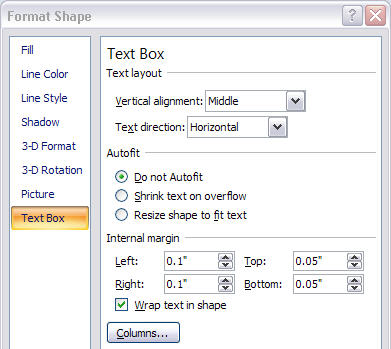Position text in a shape or text box in PowerPoint 2007
Text boxes and most shapes (except for lines, connectors, and freeform shapes) can include text that attaches to the shape or text box and can be positioned or wrapped. You can also change the margins of text boxes and shapes for optimal spacing, resize shapes for a better text fit, or change the direction of the text.
What do you want to do?
Position text horizontally in a shape or text box
To change the horizontal alignment of a single paragraph or line:To change the horizontal alignment of all text in a shape or text box: 3. Click the border of the shape or text box to select it. 4. On the Home tab, in the Paragraph group, click the horizontal alignment option that you want.
-
Click in the paragraph or line of text that you want to modify.
-
On the Home tab, in the Paragraph group, click the horizontal alignment option that you want.

To change the horizontal alignment of all text in a shape or text box:
-
Click the border of the shape or text box to select it.
-
On the Home tab, in the Paragraph group, click the horizontal alignment option that you want.

Position text at the top, bottom, or middle of a shape or text box
You can specify the vertical alignment of text in a shape or text box.
-
Right-click the border of the shape or text box.
-
On the shortcut menu, click Format Shape, and then click Text Box in the left pane.

-
Under Text layout, select the option that you want in the Vertical alignment list.
Wrap text in a shape or text box
When you wrap text, the text appears on multiple lines inside a shape or text box.
-
Right-click the border of the shape or text box that contains the text that you want to wrap.
-
On the shortcut menu, click Format Shape, and then click Text Box in the left pane.

-
Under Internal margin, select the Wrap text in shape check box.
Notes: In a text box, the text wraps as you soon as you type additional text.
For more information about wrapping text around an object, such as a shape or a text box, see Wrap text around an object in PowerPoint 2007.
Change the margins between text and the edge of a shape or text box
The internal margin is the changeable distance between text and the outer border of a shape or text box.
-
Right-click the border of the shape or text box for which you want to adjust the margin.
-
On the shortcut menu, click Format Shape, and then click Text Box in the left pane.

-
Under Internal Margin, do one or more of the following:
-
To specify the distance between the left border of a shape and the text, enter the new margin number in the Left box.
-
To specify the distance between the right border of a shape and the text, enter the new margin number in the Right box.
-
To specify the distance between the top border of a shape and the text, enter the new margin number in the Top box.
-
To specify the distance between the bottom border of a shape and the text, enter the new margin number in the Bottom box.
-
Resize a shape to fit text
You can automatically increase the size of a shape or text box vertically so that the text fits inside it.
-
Right-click the border of the shape or text box that you want to resize.
-
On the shortcut menu, click Format Shape, and then click Text box in the left pane.

-
Under Autofit, click Resize shape to fit text.
Tip: You can reduce the size of the text to fit it in the shape or text box by clicking Shrink text on overflow.
Specify text direction in a shape or text box
-
Right-click the border of the shape or text box that contains the text.
-
On the shortcut menu, click Format Shape, and then click Text Box in the left pane.

-
Under Text layout, select the option that you want in the Text direction list.
Notes:
-
If you want to rotate an entire shape or text box, instead of rotating only the text inside the shape or text box, see Rotate or flip a picture, shape, text box, or WordArt.
-
For additional information about the options in the Text Box pane of the Format Shape dialog box, click Help
 at the top of the dialog box.
at the top of the dialog box.
-
No comments:
Post a Comment